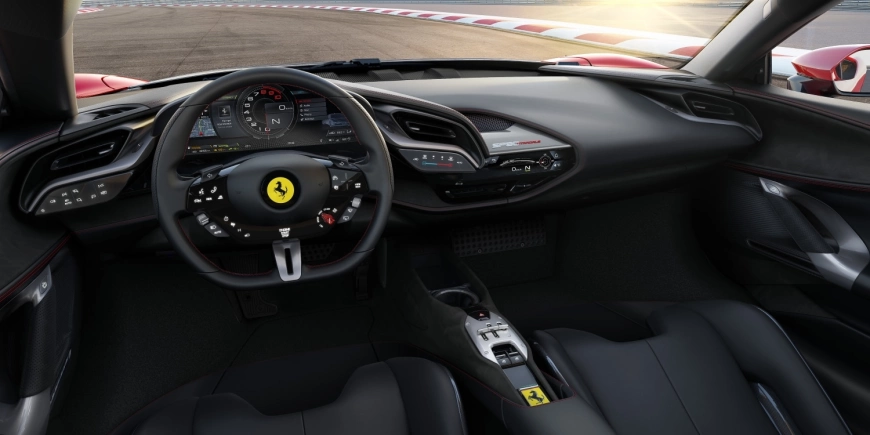Ferrari SF90 Stradale
The Ferrari SF90 Stradale is the new top-level Ferrari and their answer to what a Plug-in Hybrid Electric Vehicle should be if it were to be sporty and have some performance.
 Photo by Ferrari
Photo by Ferrari
The car’s name encapsulates the true significance of all that has been achieved in terms of performance. The reference to the 90th anniversary of the foundation of Scuderia Ferrari underscores the strong link that has always existed between Ferrari’s track and road cars. A brilliant encapsulation of the most advanced technologies developed in Maranello, the SF90 Stradale is also the perfect demonstration of how Ferrari immediately transitions the knowledge and skills it acquires in competition to its production cars.
The SF90 Stradale is the first-ever Ferrari to feature PHEV (Plug-in Hybrid Electric Vehicle) architecture which sees the internal combustion engine integrated with three electric motors, two of which are independent and located on the front axle, with the third at the rear between the engine and the gearbox.
Still a V8
The SF90 Stradale has a 90 degree V8 turbo engine capable of delivering 780 cv, the highest power output of any 8-cylinder in Ferrari history. The remaining 220 cv is delivered by three electric motors, one located between the engine and the new 8-speed dual-clutch transmission on the rear axle, and two on the front axle. This sophisticated system does not, however, make for a more complicated driving experience. Quite the opposite, in fact: the driver simply has to select one of the four power unit modes, and then just concentrate on driving. The sophisticated control logic takes care of the rest, managing the flow of power between the V8, the electric motors, and the batteries.
The SF90 Stradale is equipped with three electric motors capable of generating a total of 220 cv (162 kW). A high-performance Li-ion battery provides power to all three motors and guarantees a 25-kilometer range in all-electric eDrive mode, using just the front axle. When the internal combustion engine is turned off, the two independent front motors deliver a maximum speed of 135 km/h with a longitudinal acceleration of ≤ 0.4 g. The reverse can only be used in eDrive mode which means the car can be maneuvered at low speeds without using the V8. This mode is ideal for city-center driving or any other situation in which the driver wishes to eliminate the sound of the Ferrari V8.
This is the default setting when the car is turned on, in which the power flows are managed to optimize the overall efficiency of the system. The control logic autonomously decides whether to keep the internal combustion engine running or turn it off. If it is on, the internal combustion engine can run at maximum power thus guaranteeing powerful performance whenever the driver requires.
The internal combustion engine, gearbox, turbo-charged air, battery pack, and electric motors, the inverters and charging systems, and brakes all need cooling. Meticulous attention was paid to the design of the engine bay which houses both the usual internal combustion engine systems that generate temperatures of nearly 900 degrees Celsius, and highly temperature-sensitive electronic components.

4WD Ferrari?
The exceptional work done to boost the power unit’s power would have all been in vain without in-depth dynamics research and the development of a whole series of solutions to boost the SF90 Stradale’s lap times, whilst simultaneously guaranteeing that drivers of all kinds could make full use of the car’s potential and have fun behind the wheel.
The new hybrid architecture required extensive and lengthy integration work on the car’s many different control logic. The three areas concerned are the high-voltage system controls (battery, RAC-e, MGUK, inverter), engine and gearbox control, and vehicle dynamics controls (traction, braking, Torque Vectoring).
Integrating these areas with the existing vehicle control logics led to the development of the new eSSC (electronic Side Slip Control) vehicle control system. The eSSC introduces three innovative dynamic regulation and distribution strategies for engine torque to all four wheels:
- Electric Traction Control (eTC): optimally manages the availability of the torque - both ICE and electric - distributing it to the individual wheels to suit driving conditions and grip requirements
- Brake-by-wire control with ABS/EBD: allows the braking torque to be split between the hydraulic system and the electric motors (brake torque blending), allowing regenerative recovery under braking which actually boosts performance and brake feel rather than compromising them
- Torque Vectoring: available on the front axle to manage electric traction on the outside and inside wheel in cornering to maximize traction exiting the corner and help ensure easy, confident, high-performance driving.
Find more Cars
The new Porsche 911 Carrera T
With the 911 Carrera T, Porsche is reviving the puristic concept behind the...
The Lamborghini Huracán Tecnica
The Lamborghini Huracán Tecnica is an aerodynamically, driver-focused creat...
Lamborghini Huracán LP 610-4 Spyder
The open-top version of the Lamborghini Huracán LP 610-4 combines the power...
The new Bentley Flying Spur
The all-new Bentley Flying Spur offers a unique combination of limousine lu...
McLaren Elva
The McLaren Elva is the lightest road car ever from McLaren Automotive, wit...
The New Aston Martin Lagonda
Aston Martin confirms a bespoke product program for a new super saloon that...




















